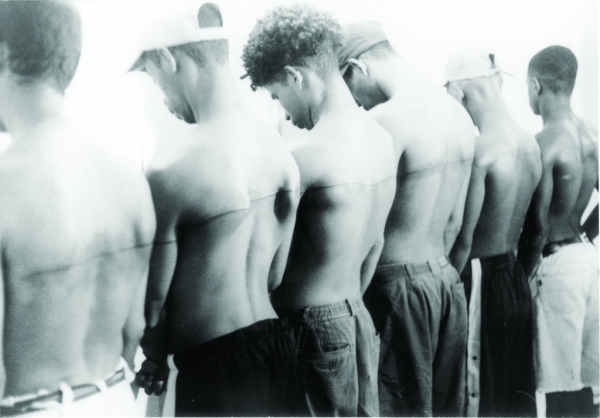
Once in class, I asked a Postechian how much money it would take before he would allow someone to put a tattoo on his body. He was a person who did not currently have any tattoos and did not plan on getting one in the future. He said that he would only consider it for 100 million KRW, and other Postechians nodded in agreement. The conversation highlighted the reluctance of individuals to allow an indelible mark on their bodies against their wishes. Indeed, even a simple line drawn on one's back could be difficult to accept, as it would still be a permanent and unwanted alteration to one's body.
In 1999, the Spanish artist Santiago Sierra (born 1966) hired six young, unemployed men who were wandering the streets of Havana, Cuba, lined them up in a row, and tattooed a straight line spanning 250 centimeters across their backs. The resulting line became Sierra’s artwork entitled 250 cm Line Tatooed on 6 Paid People. Sierra paid each participant 30 USD (equivalent to a little more than 30,000 KRW). Sierra carried out the same projects in many cities on various individuals, who were marginalized members of society, including illegal immigrants, homeless people, drug addicts, and sex workers. Sierra's work, as such, operates outside the boundaries of the law, which is supposed to protect the citizens, but highlights the irony that those who are outside the legal protection are actually the most constrained by the law and often compelled to engage in inhumane and degrading work.
Despite the unethical nature of Sierra's work, he remains confident that there are always people in the world who are willing to offer up their bodies for such purposes. He, for example, hired 133 mostly black foreigners to dye their hair in blonde in the Venice Biennale, had workers sit still inside a large carton box for four hours a day in an art gallery, had museum watchman stay overnight behind a wall constructed in the museum, and other peculiar things. When the museum visitors realized that actual people were confined inside the tattered boxes or locked in a wall, they undoubtedly felt uncomfortable or even disgusted. Despite the discomfort it caused, however, Sierra proudly proclaimed that he did not distinguish between art materials and people. He saw human bodies as capable of being painted and colored just as a canvas can and believed that just as artists pay for their paint, he could buy people for his art. For an interview, Sierra stated:
“At the Kunstwerke in Berlin they criticized me because I had people sitting for four hours a day, but they did not realize that a little further up the hallway the guard spends eight hours a day on his feet. You want to stick your finger in the wound and say that the work is definitely torture, that it is indeed a punishment of biblical proportions. And when you put your name on the work it seems that you are held responsible for the capitalist system itself. Many of the people who make those criticisms have never worked in their lives; if they think it’s a horror to sit hidden in a cardboard box for four hours, they do not know what work is.”
This statement is sure to anger many people, but upon closer reflection, it is also a call for self-criticism. It highlights the commodification of individuals in our society, where people can be bought and sold for various purposes, often without regard for their humanity and dignity. While Sierra's methods are certainly controversial and not without criticism, they force us to confront uncomfortable truths about the treatment of individuals in our society. Sierra's project thus prompts feelings of discomfort and guilt in the viewer, especially as he identifies the art world's visitors as primarily wealthy, well-educated, and highly privileged individuals.
Sierra's art also challenges the idea that collaboration and participation are always positive and preferable, especially for a democratic society. He often uses his work to expose the inequalities and injustices that exist within society, and to question whether genuine collaboration and participation are even possible under current societal structures. Sierra's works involve the exploitation of marginalized and vulnerable individuals, such as the homeless or undocumented immigrants, who are paid to perform labor that is often physically demanding or degrading: can these be counted as participation and collaboration? Sierra highlights the power dynamics within society and how certain individuals and groups are excluded from the utopian ideals of participation and collaboration.
To make us confront the uncomfortable reality of where we are: this is the most crucial function of art now and then.



